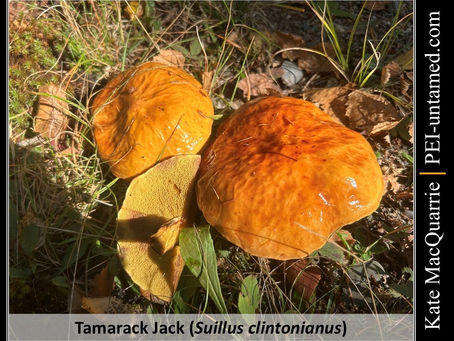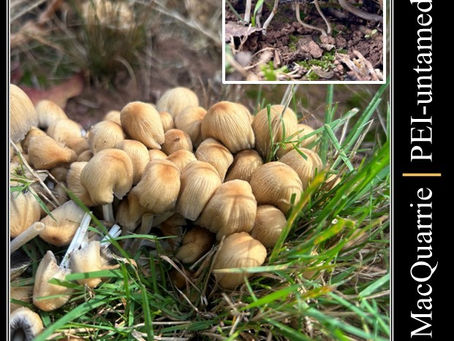top of page


Slippery Jacks
Welcome back to Mushroom Monday, your weekly look at some of PEI’s fascinating fungi. Today we have not one species but a whole group that’s both reasonably easy to identify and edible: Suillus species, many of which are called Slippery Jacks. The first thing you’ll notice about a Slippery Jack is the feature that gives it that common name: a somewhat slimy or sticky cap. These mushrooms do indeed look slippery, especially after rain. Peek under that cap and you’ll see Slip
katemacquarrie22
5 hours ago3 min read


Cocklebur
If I had to design vegetation for a movie set on an alien planet, I’d take inspiration from this PEI plant: the odd-looking Rough Cocklebur ( Xanthium strumarium ). Cocklebur gets its name from spine-covered fruit (burs) that look a bit like Burdocks but have two distinctive beaks at the end (inset photo). Like Burdock ( Arctium minus ), Cocklebur’s Velcro-like fruits are distributed by hitch-hiking on animals, including humans. Those burs also float, allowing them to be r
katemacquarrie22
4 days ago2 min read


Orange Peel Fungus
Welcome back to Mushroom Monday, your weekly look at some of PEI’s fascinating fungi. Not all mushrooms have the cap-and-stem look we tend to expect, and today’s species is a well-named example of a different format: meet Orange Peel Fungus ( Aleuria aurantia ). Orange Peel Fungus is one of the cup fungi, similar to the Scarlet Elfcup we looked at last spring (you can find it here: https://www.pei-untamed.com/post/scarlet-elf-cups ). Orange Peel Fungus’ most eye-catching feat
katemacquarrie22
Nov 162 min read


Woolly Alder Aphids
Welcome back to Ask a Naturalist, your own personal Google for information on all things natural on PEI. Today we have an insect that people often mistake for a fungus. Meet Woolly Alder Aphids ( Prociphilus tessellatus ). From a distance, Woolly Aphids do look like some sort of fluffy, fungal mould on the branch of a tree. But take a closer look and you’ll see that those fuzzy clusters are actually dozens – sometimes hundreds – of individual insects crowded together. The
katemacquarrie22
Nov 122 min read


Shaggy Parasols
Welcome back to Mushroom Monday, your weekly look at some of PEI’s fascinating fungi. I taste-tested today’s species for the first time this year, and it’s now among my favourite edible wild mushrooms. Meet the Olive Shaggy Parasol ( Chlorophyllum olivieri ). Shaggy Parasols are large, eye-catching mushrooms that can be found in grassy, open areas as well as in forests (especially under Spruce). Field guides often list them as lookalikes for edible Shaggy Manes, but they’re n
katemacquarrie22
Nov 92 min read


Bearberry
PEI has more than 30 native, wild plants with edible berries, but here’s one of the lesser-known: Bearberry ( Arctostaphylos uva-ursi ). Bearberry doesn’t compete taste-wise with some of our other wild fruit. Raw, the berries are dry and bland (but that’s probably just as well, because too many raw berries can have a laxative effect). Cooking improves their flavour and texture, and Bearberries make pleasant preserves, interesting additions to soups or stews, and excellent
katemacquarrie22
Nov 52 min read


Blewits
Welcome back to Mushroom Monday, your weekly look at some of PEI’s fascinating fungi. Today’s species is both beautiful and delicious. Meet the Blewit ( Collybia nuda ). ‘Blewit’ is an odd-sounding name, and the most common explanation is that it’s a shortened form of ‘Blue Hat’, referring to the colour of younger specimens. That’s plausible, though I’m not entirely convinced: these mushrooms are more purple or lilac than blue (main photo). While distinctive, that colour is
katemacquarrie22
Nov 22 min read


Bog Birch
This fall, we’ve been exploring some of PEI’s least-common trees, including Balsam Poplar, Ironwood, and Jack Pine. Today it’s one many people haven’t even heard of: Bog Birch ( Betula pumila ). We often think of Birch as among the majestic trees of PEI’s early forests. Nineteenth century writers told of Yellow Birch ( Betula alleghaniensis ) three to four feet in diameter, and it was said that Mi’kmaq people were able to make a six-person canoe from the bark of a single Wh
katemacquarrie22
Oct 292 min read


Sweetbread Mushrooms
Welcome back to Mushroom Monday, your weekly look at some of PEI’s fascinating fungi. It’s often helpful to use more than just sight when identifying mushrooms, and today’s species has a very distinctive smell. Meet Sweetbread Mushroom (aka The Miller, Clitopilus prunulus ). I confess that I generally don’t pay much attention to small mushrooms with white caps and gills. I’m sure they’re perfectly lovely, but I tend to assume they exceed my limited identification skills. Af
katemacquarrie22
Oct 262 min read


Holey Rocks
PEI’s shores are full of interesting finds, including holey rocks like this one. At first glance, you may think this stone was shaped by waves and tides, but the creators of these holes are biological, not physical. Rocks like this are sometimes called witches’ stones, hag stones, or adder stones, although those terms are more commonly applied only if one or more of the holes passes all the way through. According to legend, witches’ stones bring good luck by letting only good
katemacquarrie22
Oct 222 min read


Mica Caps
Welcome back to Mushroom Monday, your weekly look at some of PEI’s fascinating fungi. Little brown mushrooms can be tricky to identify, but today’s species has features that help it stand out: meet Mica Caps ( Coprinellus micaceus ). Mica Caps are part of the Inky Cap group of mushrooms, just like the Shaggy Manes ( Coprinus comatus ) I’ve posted about before. Although these two species share a similar approach to spore dispersal, they’re not closely related. As we’ve seen in
katemacquarrie22
Oct 192 min read


Wild Lily-of-the-Valley
You may think of summer as peak season for PEI’s wild berries, but a few tasty treats are at their best this time of year. One of my fall favourites is Wild Lily-of-the-Valley (aka Canada Mayflower, Maianthemum canadense). Wild Lily-of-the-Valley is NOT the same as the popular garden plant of the same name. The sweet-smelling European Lily-of-the-Valley ( Convallaria majalis ) contains toxic cardiac glycosides that can cause nausea, vomiting, diarrhoea, and irregular heart
katemacquarrie22
Oct 152 min read


False Chanterelle
Welcome back to Mushroom Monday, your weekly look at some of PEI’s fascinating fungi. Today’s species is one I’ve known about for decades...
katemacquarrie22
Oct 122 min read


Balsam Poplar
Most Islanders are familiar with Poplar (aka Trembling Aspen, featured last week), and many know of its relative, Large-tooth Aspen. But...
katemacquarrie22
Oct 82 min read


Common Puffball
Welcome back to Mushroom Monday, your weekly look at some of PEI’s fascinating fungi. Today, it’s one of the most common and widespread...
katemacquarrie22
Oct 52 min read


Trembling Aspen
One of PEI’s most common trees is Poplar, aka Trembling Aspen ( Populus tremuloides ). The ‘trembling’ name comes from the habit of this...
katemacquarrie22
Oct 12 min read


Brown Roll-Rim
Welcome back to Mushroom Monday, your weekly look at some of PEI’s fascinating fungi. This week we have the interesting, toxic, and...
katemacquarrie22
Sep 282 min read


Star Tunicate
Welcome back to Ask a Naturalist, your own personal Google for information on all things natural on PEI. I recently received this...
katemacquarrie22
Sep 242 min read


Birch Polypore
Welcome back to Mushroom Monday, your weekly look at PEI’s fascinating fungi. We’re staying with the Polypore group for another week to...
katemacquarrie22
Sep 212 min read


Ironwood
Most people have never seen PEI’s rarest native tree in person, and some have never even heard of it. Meet the beautiful Ironwood (...
katemacquarrie22
Sep 172 min read
bottom of page
